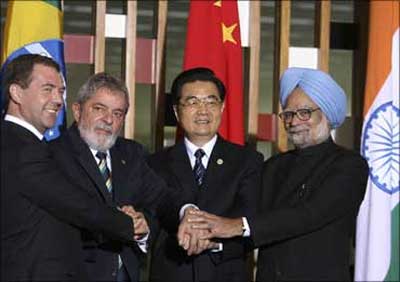
The third BRIC summit in Sanya, China, on Thursday will have a new member: South Africa.
Ten years after Goldman Sachs drew up the concept, BRIC has become something of an international phenomenon.
South Africa will officially join the BRIC - Brazil, Russia, India, China - formation on Thursday at the third BRIC summit in Sanya, southern China. The organisation will now be called BRICS, though BRICSA has also been suggested.
Russia has the highest GDP per capita among the existing BRIC countries: $18,945. Brazil comes next at $10,427, with China third at $6,675. India comes in last at $3,248 (Source: The World Bank, September 2010).
But wait. According to a recent blog on The Economist site, most of BRICS will be growing at 'decidedly un-BRIC-like growth rates.' The only exception, the magazine felt, could be India, whose demographics are far more favourable and 'likely to add 2 per cent points to annual growth for the next 20 years.'
Jim O'Neill, then chief economist, Goldman Sachs, conceived BRIC ten years ago as 'large, developing countries with the potential over the next few decades to become a much larger force in the world economy.'
Prime Minister Manmohan Singh once noted that BRIC is an attempt to give life to a Goldman Sachs concept.
...

Russia is growing at 2 per cent, Brazil at about 7.5 per cent, India at 8 per cent and China at more than 10 per cent.
"Without China, the BRICs are just the BRI, a bland soft cheese that is primarily known for the whine that goes with it," wrote David Rothkopf in Foreign Policy. "China is the muscle of the group and the Chinese know it. They have effective veto power over any BRIC initiatives because without them, who cares really?"
This is probably why China's invitation to South Africa to join BRIC last winter apparently took India by surprise though Commerce and Industry Minister Anand Sharma denied it vehemently when Rediff.com asked him this on Tuesday. The Hindu's correspondent in Beijing, Ananth Krishnan, reported on Wednesday that BRICS is the new focus of China's multilateral diplomacy.
Economists feel Nigeria has better credentials than South Africa to represent that continent in BRIC.
At 150 million it is 20 per cent of Africa's population, and its economy could double in maybe 20 years. But China, it is felt, wanted 'political capital' in Africa and South Africa offers Beijing a gateway into the continent, furthering Chinese commercial interests.
...

Interestingly, China is the largest trading partner for Brazil, India and South Africa; it is the third largest trading partner for Russia.
According to Goldman Sachs, by 2020, BRIC will contribute 49 per cent of the world's GDP growth.
BRIC already accounts for 40 per cent of the world's population. According to the China Center for International Economic Exchanges, BRICs will contribute almost half the world's output by 2030, rising from 17 per cent in 2010 to 47 per cent in 2030.
Russia has the richest people in BRIC, twice as well off as the average Chinese, and fives times better off than the average Indian (Source: Russia Beyond The Headlines).
According to the Russian investment bank Troika Dialog, 68 per cent of the Russian population (100 million) is middle class, compared to 31 per cent of Brazilians (75 million), 13 per cent of Chinese (160 million), and less than 3 per cent of Indians (30 million).
...

Writing in The National, Harvey Jones noted that since February, the BSE Sensex had fallen 10 per cent with investors withdrawing more than $1.5 billion; Brazilian stocks were down 4 per cent, the Chinese economy had flattened out with a trade deficit of $7.3 billion, the largest in eight years. Only the Russian economy, boosted by its oil sales, held up.
German Finance Minister Wolfgang Schaeuble said last month that the G-7 and BRICS could join forces to reform the global monetary system.
Indian economists are compiling a detailed study of the BRICS economies and will submit at the next BRICS summit, which is likely to be held in India next year.
For the first time in BRIC history, all its members are on the United Nations Security Council - China and Russia, of course, are permanent members; Brazil, India and South Africa are non-permanent members for the next two years.
...

One observer writing on the Foreign Policy blog felt that BRICS as a group will 'have a lot less influence after the expiration of the UNSC membership of Brazil, India, South Africa unless any of these three become permanent UNSC members by then.'
Expressing the Chinese point of view on this, Liu Youifa of the China Institute of International Studies felt the 'timing is not right to have a common political agenda. The reason why the BRIC countries came together is because of the similar economic development stage they are in and similar foreign trade structure. Political agenda is not a key concern for the BRICS mechanism at this point of time. Maybe in the future, but not at this stage.'
India sees BRICS as another forum to engage China, with which it has an inimical equation in recent times; with Russia, its friend of over half-a-century; and with Brazil and South Africa, with which it has developed strong ties in recent years.
As one Indian government official put it, "BRICS is part of the open, pluralateral international system, which we want to be part of."